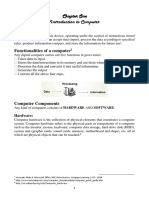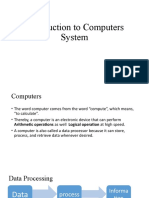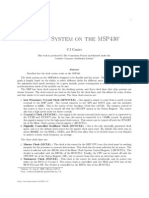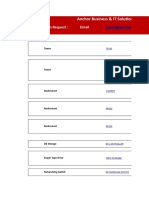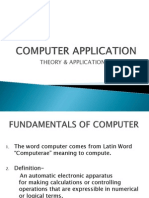Computer Fundamentals
Introduction
• Computer is an electronic device i.e. used to work with information or
compute.
• It is derived from the Latin word "computare" which means to
calculate.
• Computer is an advanced electronic device that takes raw data as an
input from the user and processes it under the control of a set of
instructions (called program), produces a result (output), and saves it
for future use.
�Functionalities of a Computer
• Any digital computer carries out the following five functions −
• Step 1 − Takes data as input.
• Step 2 − Stores the data/instructions in its memory and uses them as
required.
• Step 3 − Processes the data and converts it into useful information.
• Step 4 − Generates the output.
• Step 5 − Controls all the above four steps.
�Computer Parts or Components
• There are 5 main computer components
• Input Devices
• CPU
• Output Devices
• Primary Memory
• Secondary Memory
�Input devices
• A computer system's input devices are important because they allow
users to enter commands and data.
• Keyboards, mice, scanners, and microphones are numerous examples
of input devices.
�Output Devices:
• Output devices are hardware components of a computer system that
are used to show or send data from the pc to the user or any other
device.
• They enable customers to view and engage with the information and
applications the computer is processing.
• Speakers, projectors, printers, and monitors are a few examples of
output devices.
� CPU (Central Processing Unit)
• A computer machine's "brain" is its central processing unit (CPU).
• It executes the calculations and commands required for functioning of
the computer device.
• The CPU comprises some components: the control unit, the
arithmetic logic unit (ALU), and registers.
�Primary Memory
• The CPU has direct access to primary memory, sometimes referred to
as random access memory (RAM).
• The data and instructions that are currently being processed are kept
in primary memory.
• The data and instructions are accessed by the CPU from primary
memory when a computer programme is running.
• The information is removed from primary memory once the
programme is completed.
�RAM and ROM
RAM ROM
• RAM is the most common form • ROM is a form of memory this is
of primary memory and is used used to store data and
to store data and instructions instructions that don't change.
that the CPU wishes to access • ROM is non-volatile, which
frequently means that its contents aren't
• RAM is volatile, which means lost while the computer is
that its contents are lost when turned off.
the computer is turned off.
�Secondary Memory:
• Secondary memory, also called auxiliary storage, is a type of
computer memory that is used to store data and programs that aren't
currently being utilized by the CPU.
• In contrast to primary memory, secondary memory is non-volatile,
which means that its contents are not lost when the computer is
turned off.
• There are several types of secondary memory devices, such as hard
disk drives (HDD), solid-state drives (SSD), optical disks (including CDs
and DVDs), and USB flash drives.
�Software
"Software is a set of programs (sequence of instructions) that allows the users to perform a well-defined
function or some specified task."
�Types of Software
• Software's are broadly classified into two types, i.e., System Software
and Application Software.
• System Software
• System software is a computer program that helps the user to run computer
hardware or software and manages the interaction between them.
• Essentially, it is software that constantly runs in the computer background,
maintaining the computer hardware and computer's basic functionalities,
including the operating system, utility software, and interface.
• In simple terms, you can say that the system acts as a middle man that checks
and facilitates the operations flowing between the user and the computer
hardware
�Types of System Software
• Operating System
• The operating system is the most prominent example of system software that acts as
an interface between the user and system hardware.
• It is a group of software that handles the execution of programs and offers general
services for the application that runs over the computer.
• There are various types of operating systems available in the market, such as
embedded operating systems, real-time OS, distributed OS, single or multi-user
operating system, mobile, Internet, and various others.
• Examples of operating systems are given below.
• Microsoft Windows
• Apple's iOS
• Apple's MacOS
• Android
• CentOS
• Linus
• Ubuntu
• Unix
�Device Drivers
• In computing, the device driver is a type of software that operates or
controls some specific hardware devices linked to your system.
• They provide a software interface to hardware devices allowing computer
operating systems and other applications to fetch hardware functions
without knowing the exact specifications of the hardware.
• Some common examples of such device drivers that connect hardware
devices (printers, sound cards, network cards, hard disks, floppy disk,
keyboard, mouse, etc.) to a system easily are as follows:
• USB (Universal Serial Bus) Drivers
• Motherboard Drivers
• Display Drivers
• Printer Drivers
• Sound Card Driver
• ROM (Read-only memory) Drivers
• VGA (Video Graphic Array) Drivers
�Application Software
• Application programs or software applications are end-user computer programs
developed primarily to provide specific functionality to the user.
• The applications programs assist the user in accomplishing numerous tasks such
as doing online research, completing notes, designing graphics, managing the
finances, watching a movie, writing documents, playing games, and many more
• Word Processors
• MS Word (Microsoft)
• iWork-Pages (Apple)
• Corel WordPerfect
• Google Docs
• Database Software
• Oracle
• MS Access
• SQLite
• Microsoft SQL Server
�Web Browsers
• These are a type of software that is globally used to browse the
Internet.
• Web browsers help the users in positioning as well as fetching data
across the web.
• Chrome
• Mozilla Firefox
• Microsoft Internet Explorer
• Opera
• Microsoft Edge



